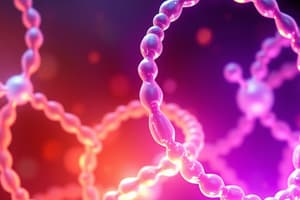Podcast
Questions and Answers
What is the term for the building blocks of macromolecules?
What is the term for the building blocks of macromolecules?
- Substrates
- Enzymes
- Monomers (correct)
- Polymers
Which process involves adding water to break apart larger molecules?
Which process involves adding water to break apart larger molecules?
- Dehydration synthesis
- Hydrolysis (correct)
- Anabolism
- Denaturation
What class of molecules are enzymes primarily made of?
What class of molecules are enzymes primarily made of?
- Lipids
- Nucleic Acids
- Carbohydrates
- Proteins (correct)
Which term refers to the creation of larger molecules from smaller ones?
Which term refers to the creation of larger molecules from smaller ones?
What happens to enzymes when they denature?
What happens to enzymes when they denature?
What is the substrate of the enzyme amylase?
What is the substrate of the enzyme amylase?
Which indicator turns deep blue in the presence of starch?
Which indicator turns deep blue in the presence of starch?
What happens to Benedict’s Reagent in the presence of reducing sugars?
What happens to Benedict’s Reagent in the presence of reducing sugars?
At what pH does amylase function optimally?
At what pH does amylase function optimally?
Which enzyme catalyzes the hydrolysis of lipids?
Which enzyme catalyzes the hydrolysis of lipids?
Study Notes
Macromolecules
- Building blocks of macromolecules are known as monomers.
Biological Processes
- The process of adding water to split larger molecules is called hydrolysis.
- Dehydration synthesis describes the creation of larger molecules from smaller subunits.
Enzymes
- Enzymes are primarily composed of proteins.
- When enzymes denature, they lose their functional shape, which impairs their catalytic activity.
Specific Enzymes and Substrates
- The substrate for the enzyme amylase is starch.
Chemical Indicators
- Iodine indicator turns deep blue in the presence of starch.
- Benedict’s Reagent changes color in the presence of reducing sugars, typically resulting in a color change from blue to green, yellow, or red, indicating the presence of sugars.
Optimal Conditions
- Amylase functions optimally at a pH of around 7 (neutral).
Lipid Hydrolysis
- The enzyme that catalyzes the hydrolysis of lipids is known as lipase.
Studying That Suits You
Use AI to generate personalized quizzes and flashcards to suit your learning preferences.
Description
Test your knowledge on the four classes of biologically relevant molecules: Proteins, Carbohydrates, Lipids, and Nucleic Acids. Learn about macromolecules, monomers, polymers, synthesis processes like dehydration synthesis and hydrolysis, and the concept of anabolism.




